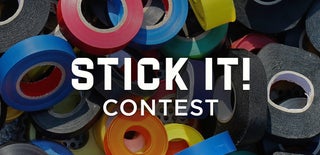Introduction: LED Ring - Inspired by Detroit: Become Human
A friend of mine asked if I could make something like the ring out of the game "Detroit: Become Human",
I initially tried to use sanded acrylic, which didn't work well. Then I used blurred film on the acrylic which also didn't work the best.
I finally settled on using hotglue and casting it in a 3D printed mould. Which is my entry to the "Stick It!" competition.
The parts list is quite basic, you could switch out the 3d prints with rings cut from wood and cardboard if one isn't available:
- 3D printer
- Arduino
- Hot glue gun with clear glue
- Wire
- LED
- Wire strippers (the £1.20 ones from china work fine)
Step 1: Salvage LED From Strip
To start with you need to find an RGB led, I found that using a WS2812B or similar is best, this is due to their low profile.
I had tried using a traditional RGB LED but its footprint was too large and left dark areas.
To start with you need to cut away the excess PCB from the back of the LED, we do this so that it is hidden behind the glue. We also keep some of the PCB so we can use its adhesive backing, this comes in handy later.
Step 2: Solder Stripped LED and Wire Arduino
Once you have stripped your LED back to a small PCB you need to solder three wires onto the LED itself. Note: If you are using a different LED chip you might have to use an extra wire for the clock, WS2812B LEDs just use 1 line for data.
I used an arduino nano for my project to make it easier to carry, I power it using a cheap powerbank that is just a single cell and find it runs great.
Step 3: Prepare and Print Parts
Since this project uses hot glue to make the transparent LED holder I decided to 3d print a cast for the glue.
I have found that printing on glass yields the best results, this is because we use the print bed for the casting as well as the printing. We do this so the inner circle is perfectly centred in the whole assembly. The assembly is just a hollow ring with a disc in the centre.
Step 4: Glue Casting
Once the parts are printed now its time to add the glue and the LED itself.
Again, we cast on the printer so we need to leave the parts on there for now. Fill the void with glue and then add the cap and LED.
Step 5: Removing the Cast and Cleaning
Once the cast is fully cooled its time to peel it off the printing surface, all the plastic will come with it, that is fine as we snip it off anyway.
The outer plastic ring is trickier to remove, I tend to take some wire cutters to it and just snip it off that way in stages, making sure to avoid slashing the cast itself.
Step 6: Final Thoughts and Future Improvements
Congrats you have reached the end!
Some potentional additions to this could be:
- Remove the need for a 3D printer
- Make the design even smaller
This is my entry to the "STICK IT! " contest if you enjoyed this instructable, please vote below :)

Participated in the
Stick It! Contest










